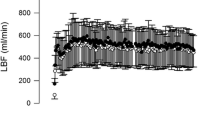Summary
In 20 patients we studied the changes in calf arterial blood flow (AF) following spinal and epidural blocks, using venous occlusion strain gauge plethysmography (SGP). AF was calculated both in the conventional way by drawing a tangent to the initial upslope of the curve, and by a new method which measures the time to the point when 50% of venous capacity is reached (tVC50). The statistical differences within and between the spinal and epidural groups for AF and tVC50 were determined. In measuring the post-block changes in AF as compared with the control values, a statistically significant correlation (rs=−0.85, p<0.01) was observed between the two methods. We conclude that the new variable, tVC50, seems to be potentially useful in calculating changes in arterial blood flow at rest, and could be used, for example, in connection with surgical and pharmacological interventions, especially when the initial upslope of the SGP curve is equivocal.
Similar content being viewed by others
References
Bygdeman S, Pernow B (1978) Venös ocklusionsplethysmografi. In: Pernow B (ed) Perifer cirkulation. Almqvist & Wiksell, Stockholm, pp 61–74
Graf K (1964) Ausweitung und Messfehler okklusionsplethysmografischer Durchblutungsregistrierungen. Acta Physiol Scand 60:120
Hallböök T, Göthlin J (1971) Strain gauge plethysmography and phlebography in diagnosis of deep vein thrombosis. Acta Chir Scand 137:37–52
Knox R, Cramer M, Fell G, Breslau P, Beach K, Strandness DE Jr (1982) Pitfall of venous occlusion plethysmography. Angiology 33:268–276
Krahenbuhl B, Moser G, Donath A (1984) Peroperative or postoperative deep venous thrombosis? VASA 13:19–23
LepÄntalo M (1985) Beta blockade and intermittent claudication. Acta Med Scand [Suppl 700]
Modig J, Malmberg P, Karlström G (1980) Effect of epidural versus general anaesthesia on calf blood flow. Acta Anaesth Scand 24:305–309
Perhoniemi V, Linko K (1986) Effect of spinal versus epidural anaesthesia with 0.5% bupivacaine on lower limb blood flow. Acta Anaesth Scand (in press)
Siggaard-Andersen J (1965) Obliterative vascular disease. Classification by means of the Dohn plethysmograph. Acta Chir Scand 130:190–198
Strano A, Novo S, Pinto A, Davi G (1980) The effects of beta-blocking agents on the arterial flow of the lower limbs using strain-gauge plethysmography. Folia Angiol 28:312–315
Sumner DS, Strandness DE Jr (1969) The relationship between calf blood flow and ankle blood pressure in patients with intermittent claudication. Surgery 65:763–771
Whitney RJ (1953) The measurement of volume changes in human limbs. J Physiol 121:1–27
Author information
Authors and Affiliations
Rights and permissions
About this article
Cite this article
Perhoniemi, V., Salo, H. & Sundberg, S. An alternative method for calculating changes in arterial calf blood flow at rest. Europ. J. Appl. Physiol. 55, 630–633 (1986). https://doi.org/10.1007/BF00423208
Accepted:
Issue Date:
DOI: https://doi.org/10.1007/BF00423208




